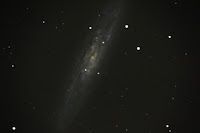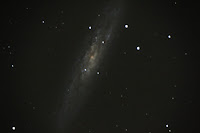 |
| Okefenokee Sunset |
 |
| The Gators' Eyes Reflected The Red from our Headlamps |
The first lesson had already been painfully learned. Using
the long drive to Georgia to mentally plan my observations, I prepared a long
agenda of objects to photograph. I have been visually observing for years.
Consequently, I prepared my observing list as a visual observing list. This was
a mistake.
Visual observers build long lineups of objects to attempt to spot. Typically, it takes me less than 15 minutes to find an object, take a few notes about the object, philosophically reflect on the object (“Wow! This tiny smudge of light contains a trillion stars, and this light left those stars while the dinosaurs roamed the earth”) and move onto the next sight. Therefore, my observing list typically consist of scores of objects to attempt.
Of course, I built my photography agenda similarly long. With
such a nice sky and view of the southern horizon, I planned to photograph dozens
of galaxies in unfamiliar southern constellations as well as clusters and
nebula along the “Backbone of The Night” – The Milky Way. I was even going to
attempt to image Neried, one of Neptune’s far-flung moons.
However, I soon discovered that imaging the heavens is very different
from visually observing the heavens. My observing plan was far too optimistic.
Even if one plans to stack ten five-minute exposures of each object, nearly an
hour of exposures is required. Adding in finding the object, centering the
object, exposing flat frames, dark frames, dark flat frames and bias frames
easily whittles down an observing list. I decimated my observing plan to five
objects each night. Imaging Neried was a pipe dream anyway.
The first object on my edited agenda was NGC 891. Very
close to the zenith this evening, NGC 891 is a beautiful edge-on galaxy in
Andromeda. It looks like a mini Milky Way. Slewing my scope toward the zenith
and utilizing an oversized dew shield, I centered the object in my field of
view, took a few test images and set the BackyardEOS application on my computer
to acquire 10 long-exposure images. As the click of the camera signaled the
start of the first exposure, I broke two important rules of astrophotography.
While my camera obediently snapped its preprogrammed sequence, I left the scope to help a friend with his set up. When I returned,
the computer screen proudly displayed the following image. What went wrong?
 |
| NGC 891 - Single Image |
Distracted by conversation with a friend, I failed to notice
the sky filled with clouds. Although the guidescope diligently tried to lock on
its guide star, passing clouds distracted its attention. The multiple images of
each star are caused by the guidescope losing its lock on its guide star and
reacquiring a guide star after the scope drifted.
Never leave your scope for a long period of time, and NEVER,
EVER stop looking up. Clouds, obstructions and strobe-flashing aircraft are
attracted to the tiny square of sky you are imaging. They will ruin your
images.
Although clouds effectively ended that night’s observing,
the next two nights promised better weather.
NGC 253 was on the top of my list. Even if I failed to image
any other object, I was not leaving Georgia without a good image of The
Sculptor Galaxy.
Many North American observers are unfamiliar with
constellation, Sculptor, The Sculptor’s Studio. Likewise, we don’t really think
about this constellation’s deep sky objects. However, it boasts one of the
brightest galaxies in the sky. From the Southern Hemisphere, The Sculptor
Galaxy passes high overhead much like The Andromeda Galaxy passes high in our
skies.
Although it passed nowhere near Georgia’s zenith, I took
advantage of my southern location to take ten images of the galaxy as it rose
to its highest point in the southern sky. After seeing the first image, I know
I succeeded in capturing The Sculptor. Here are the first four images I acquired that night.


 |
| NGC 253 - Stack of Nine Five Minute Exposures |
Fiddling with the Brightness and Contrast brought out even more
detail in the dust clouds of this starburst galaxy.
Next, I used the hue and saturation functions of Photoshop to increase the color range in the image. Although color differences could be seen in the original image, I fully admit to cheating. The central hub of The Sculptor Galaxy glows orange with the light of older stars. Meanwhile, the spiral arms are dominated by younger, bluer stars. I tried to mimic these color difference by com pairing my images to a great image returned by The Hubble Space Telescope.
 |
| NGC 253 - Color Enhanced. |
A little more tweaking of the brightness gave me a darker sky
and a prettier picture.
Finally, I cropped the image to remove that annoying dark bar on the top of the frame.
I am not happy with the resolution. The image appears blurry to me. Unfortunately, the seeing was horrible during my visit.
 |
| NGC 253 - Final Product |
I am not happy with the resolution. The image appears blurry to me. Unfortunately, the seeing was horrible during my visit.
Another issue seems more artistic than technical. During
processing, I constantly felt the galaxy should be placed differently in the field
of view. Sadly, I could not return to re-image the galaxy. However,
I did learn to spend more time on placing the object in the field of view.
Later in the evening, I was able to capture NGC 1300 in Eridanus.
NGC 6781 – A faint planetary nebula in Aquila
1) Maintain short observing lists.
2) Do your math. Do not attempt to image more objects than time allows.
3) Never leave your telescope for an extended period of time.
4) NEVER EVER stop looking up. Watch the area that you are photographing.
5) Remember aesthetics. Even a technically well-done image can appear amateurish if
the object is not well-placed in the field.
2) Do your math. Do not attempt to image more objects than time allows.
3) Never leave your telescope for an extended period of time.
4) NEVER EVER stop looking up. Watch the area that you are photographing.
5) Remember aesthetics. Even a technically well-done image can appear amateurish if
the object is not well-placed in the field.
I worded this post hoping that it leaves many questions
unanswered. The purpose of this blog is to foster a dialogue between all of us.
Feel free to ask any questions or leave comments. In the meantime, I will
create the next few posts answering the questions I have secretly embedded in
my writing.















